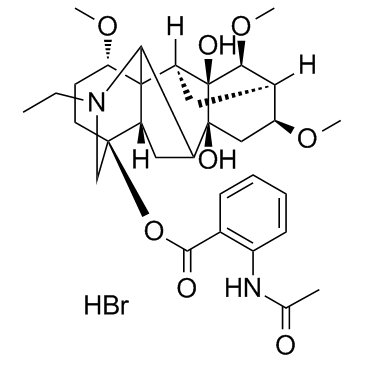CHEMICAL IDENTIFICATION
-
RTECS NUMBER :
-
AR5569600
-
CHEMICAL NAME :
-
Aconitane-4,8,9-triol, 20-ethyl-1,14,16-trimethoxy-, 4-(2-(acetylamino)benzoate), monohydrobromide, (1-alpha,14-alpha,16-beta)-
-
CAS REGISTRY NUMBER :
-
97792-45-5
-
LAST UPDATED :
-
199606
-
DATA ITEMS CITED :
-
7
-
MOLECULAR FORMULA :
-
C32-H44-N2-O8.Br-H
-
MOLECULAR WEIGHT :
-
665.70
HEALTH HAZARD DATA
ACUTE TOXICITY DATA
-
TYPE OF TEST :
-
LD50 - Lethal dose, 50 percent kill
-
ROUTE OF EXPOSURE :
-
Oral
-
SPECIES OBSERVED :
-
Rodent - rat
-
DOSE/DURATION :
-
47500 ug/kg
-
TOXIC EFFECTS :
-
Details of toxic effects not reported other than lethal dose value
-
REFERENCE :
-
GTPZAB Gigiena Truda i Professional'nye Zabolevaniya. Labor Hygiene and Occupational Diseases. (V/O Mezhdunarodnaya Kniga, 113095 Moscow, USSR) V.1-36, 1957-1992. For publisher information, see MTPEEI Volume(issue)/page/year: 35(1),30,1991
-
TYPE OF TEST :
-
LC - Lethal concentration
-
ROUTE OF EXPOSURE :
-
Inhalation
-
SPECIES OBSERVED :
-
Rodent - rat
-
DOSE/DURATION :
-
>400 mg/m3
-
TOXIC EFFECTS :
-
Details of toxic effects not reported other than lethal dose value
-
REFERENCE :
-
GTPZAB Gigiena Truda i Professional'nye Zabolevaniya. Labor Hygiene and Occupational Diseases. (V/O Mezhdunarodnaya Kniga, 113095 Moscow, USSR) V.1-36, 1957-1992. For publisher information, see MTPEEI Volume(issue)/page/year: 35(1),30,1991
-
TYPE OF TEST :
-
LD50 - Lethal dose, 50 percent kill
-
ROUTE OF EXPOSURE :
-
Oral
-
SPECIES OBSERVED :
-
Rodent - mouse
-
DOSE/DURATION :
-
35500 ug/kg
-
TOXIC EFFECTS :
-
Details of toxic effects not reported other than lethal dose value
-
REFERENCE :
-
ARZNAD Arzneimittel-Forschung. Drug Research. (Editio Cantor Verlag, Postfach 1255, W-7960 Aulendorf, Fed. Rep. Ger.) V.1- 1951- Volume(issue)/page/year: 38,892,1988
-
TYPE OF TEST :
-
LD50 - Lethal dose, 50 percent kill
-
ROUTE OF EXPOSURE :
-
Subcutaneous
-
SPECIES OBSERVED :
-
Rodent - mouse
-
DOSE/DURATION :
-
11700 ug/kg
-
TOXIC EFFECTS :
-
Details of toxic effects not reported other than lethal dose value
-
REFERENCE :
-
YHTPAD Yaoxue Tongbao. Bulletin of Pharmacology. (China International Book Trading Corp., POB 2820, Beijing, Peop. Rep. China) V.13-23, 1978-88. For publisher information, see ZYZAEU. Volume(issue)/page/year: 19,24,1984
-
TYPE OF TEST :
-
LD50 - Lethal dose, 50 percent kill
-
ROUTE OF EXPOSURE :
-
Intravenous
-
SPECIES OBSERVED :
-
Rodent - mouse
-
DOSE/DURATION :
-
8400 ug/kg
-
TOXIC EFFECTS :
-
Details of toxic effects not reported other than lethal dose value
-
REFERENCE :
-
YHTPAD Yaoxue Tongbao. Bulletin of Pharmacology. (China International Book Trading Corp., POB 2820, Beijing, Peop. Rep. China) V.13-23, 1978-88. For publisher information, see ZYZAEU. Volume(issue)/page/year: 19,24,1984
-
TYPE OF TEST :
-
LD50 - Lethal dose, 50 percent kill
-
ROUTE OF EXPOSURE :
-
Oral
-
SPECIES OBSERVED :
-
Rodent - rabbit
-
DOSE/DURATION :
-
16300 ug/kg
-
TOXIC EFFECTS :
-
Details of toxic effects not reported other than lethal dose value
-
REFERENCE :
-
GTPZAB Gigiena Truda i Professional'nye Zabolevaniya. Labor Hygiene and Occupational Diseases. (V/O Mezhdunarodnaya Kniga, 113095 Moscow, USSR) V.1-36, 1957-1992. For publisher information, see MTPEEI Volume(issue)/page/year: 35(1),30,1991 ** OTHER MULTIPLE DOSE TOXICITY DATA **
-
TYPE OF TEST :
-
TCLo - Lowest published toxic concentration
-
ROUTE OF EXPOSURE :
-
Inhalation
-
SPECIES OBSERVED :
-
Rodent - rat
-
DOSE/DURATION :
-
4800 ug/m3/17W-I
-
TOXIC EFFECTS :
-
Cardiac - other changes Kidney, Ureter, Bladder - other changes in urine composition Blood - pigmented or nucleated red blood cells
-
REFERENCE :
-
GTPZAB Gigiena Truda i Professional'nye Zabolevaniya. Labor Hygiene and Occupational Diseases. (V/O Mezhdunarodnaya Kniga, 113095 Moscow, USSR) V.1-36, 1957-1992. For publisher information, see MTPEEI Volume(issue)/page/year: 35(1),30,1991
|


